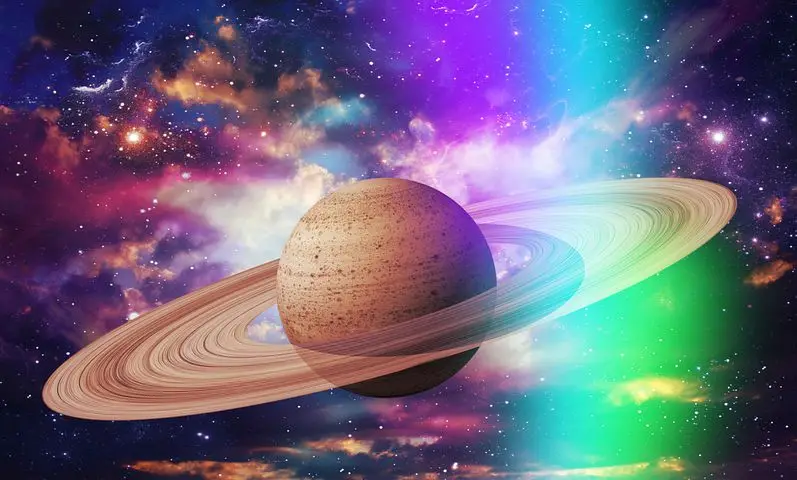
Situated at 6th place from the sun, Saturn, one of the Jovian planets, is distinguished by its beautiful rings.
If you look at the images of Saturn, you may imagine it to be a tranquil planet that you would love to live on, but appearances can be quite deceptive.
And, if you always wondered what temperature is Saturn, in this article, we’ll discuss all about this.
Ready? Let’s get started…
What Is The Temperature On Saturn: Short Summary
What temperature is Saturn? When you consider this question, you would be surprised to know as on Earth, the temperatures are not constant on Saturn and do not vary with the seasons.
The average temperature on Saturn is usually around -218°F (-138°C). At the center of the planet’s interior, the maximum temperature is around 21,000°F (11,700°C) but as you move away from the interior, the temperature becomes cooler.
Weather and Seasons On Saturn
Saturn revolves around the sun just like Earth, but it does so in around 30 years. Also, Saturn’s axis is tilted at 27° just like Earth, which is tilted at 23.5°.
This tilting at the axis causes Earth to experience changes in the seasonal temperature i.e., the temperatures are hotter during the summer, while in winter, the temperatures are cooler. Saturn also experiences seasons, but they last for over 7 Earth years.
But Saturn does not experience any changes in temperature while it orbits around the sun.
This is because although Saturn is at a distance of around 1.4 billion kilometers away from the sun and the heat radiated from the interior of the planet is a lot more than what it receives from the sun.
Saturn experiences little storms and hurricanes that occur in the atmosphere of the planet all through the year (equivalent to 29 Earth years).
Every one Saturn year (which is equal to 30 earth years), a Great White Spot or a massive storm occurs encircling the planet which is accompanied by lightning flashes. Saturn also features a hexagon-shaped cloud formation in the north pole.
Saturn’s Atmosphere And Temperature

Saturn actually does not have a surface and because it is made up of gas entirely, it is classified as a gas giant.
The surface of the atmosphere of the planet is quite nebulous and bleeds into the surface without any distinction. The planet is probably a small and rocky core that is surrounded by liquid and a thick atmosphere.
The atmosphere of Saturn mainly comprises hydrogen and helium. Other gases such as ammonia, methane, sulfur, oxygen and nitrogen are present in the atmosphere of the planet and create colorful bands.
The topmost layer of Saturn’s atmosphere is made up of clouds of ammonia ice crystals, which gives the planet its pale yellowish color. The temperature at the upper layers of Saturn’s atmosphere ranges between -280°F (-173°C) and -170°F (-113°C).
The 2nd layer of the planet’s atmosphere comprises methane and ice. The temperature of this layer ranges between -127°F (88°C) to 26°F (-3°C).
The temperature of Saturn begins to increase from the 3rd layer onward, where it is around 134°F (57°C) and at the core, the temperature is around 21,000°F (11,700°C).
Saturn’s atmospheric temperature increases along with pressure as you move towards the center of the planet.
Saturn’s Hexagon Cloud Formation
Saturn has a unique hexagon cloud formation in the north pole at 78°N that comprises jet streams traveling at high speeds of up to 320 kilometers an hour.
The moving jet stream creates a distinct hexagon shape that is around 9,000 miles (14,500 km) in length and 18,000 miles (29,000 km) in width.
The hexagon cloud formation changes color from blue to golden depending on the seasons of Saturn, which changes once in 7 Earth years.
During summer, there is increased sunlight at the poles, creating aerosols in the planet’s atmosphere, turning it into a golden color.
During winter, not much sunlight reaches the northern pole, causing a decrease in the aerosols and turn, returning the hexagon cloud to return to its original blue color.
Saturn’s Great White Spot
Just like all other planets, Saturn also experiences storms. The gas giant experiences severe storms once a year (which is 30 Earth years) that are caused due to cloud disturbances.
The Great White Spot is Saturn’s largest storm, which starts as isolated spots in the atmosphere of the planet and within a period of 6 months, it completely encloses the planet.
The storm is often accompanied by lightning flashes and sometimes, it is very common for over 10 lighting flashes to occur per second. The storm’s tail touches its head often and then it dies out.
The White Spot has occurred around 6 times in the last 140 years on Saturn and the most recent storm occurred in December 2010. While we have very clear images of the Great Spot itself, the cause of the storm is still largely unknown.
One theory states that the Great White Spot that usually occurs between the equator and mid-latitudes of the planet is probably because of the high temperatures during the summer months on Saturn that drive the winds.
Saturn’s Climate And Weather

Saturn has a very stormy climate and experiences extreme weather patterns. The planet has a hexagon cloud formation in the north pole, which we have already discussed earlier is caused because of the turbulent movements in the atmosphere.
Saturn experiences extreme wind speeds and the wind can reach speeds of up to 500 miles an hour, which is the 2nd fastest after Neptune.
All through the year, Saturn experiences small storms and hurricanes that are accompanied by lightning. This is because of the different rotation speeds of the planet’s core and atmosphere.
How Do We Have All This Information?

Humans have not traveled to Saturn, so how do we have all this information about the climate, weather, temperature and other aspects of the planet?
There have been 4 successful space missions to Saturn and although there is no surface on Saturn where a spacecraft can land, the spacecraft orbited the planet and have got plenty of images and data that have given us a lot of information about the atmospheric make-up, weather, temperature, etc. on the ringed planet.
In 1979, the first spacecraft that traveled to Saturn was Pioneer 11, which provided information about how the planet looks and also confirmed the existence of hydrogen in Saturn’s atmosphere and the planet’s magnetic field.
The spacecraft Voyager 1 in 1980 and Voyager 2 in 1981 flew by the planet and took plenty of pictures of Saturn. The images gave a lot of information about the planet, including the presence of moons.
In 2004, the Cassini mission was the one that provided scientists with all the information that gave a detailed understanding of Saturn.
Lots of questions about the planet were answered by the data collected during this mission, including those about the planet itself and the moon system.
The Cassini spacecraft studied the ringed planet for over 13 years, after which it plunged into the gaseous atmosphere, right into Saturn. The spacecraft sent back images of the ring system of Saturn, providing interior views of the planet’s rings.
Frequently Asked Questions
What Is The Hottest Temperature On Saturn?
At the core of Saturn, the temperature is around 21,000°F (11,700°C), which is much hotter than the surface temperature of the sun.
Does Saturn Have Snow?
Enceladus, the moon of Saturn, has geysers, which shoot water vapor jets into space, where the water freezes and falls back onto the planet’s surface as snow. All the snow and ice make Enceladus among the brightest objects in the solar system.
Is Saturn Suitable For Life?
No, Saturn cannot support life. This is because the planet is a gas giant made up of layers of gas, mainly hydrogen and helium, and it does not have a solid surface. As you go further into the planet’s atmosphere, the denser it becomes and the pressure squeezes the gas and turns it into a liquid.
Summary & Conclusion
In conclusion, the appearance of Saturn in images of being a calm and placid planet is rather deceptive.
All through the year, the planet experiences fast wind speeds, storms and hurricanes that are caused by the different layers of the atmosphere that rotate at different speeds.
The planet has unique features such as the hexagon cloud formation in the north pole and the Great White Spot. Like Earth, Saturn does experience seasons that last for over 7 years, but the temperature variations on the planet are not seasonal.
But the planet does experience a huge variation in the temperature as you move from the core, where it is the hottest and temperatures are around 21,000°F (11,700°C) to the outer surface, which is extremely cold and the temperature is around -280°F (-138°C) and ammonia exists here in an icy form.
